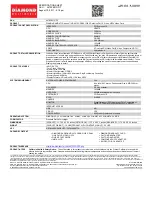
PCVisionplus
Hardware Reference
Theory of Operation
2–7
Rev 02; February 8, 2002
stepping through the memory addresses sequentially, without resetting. The image size must be taken into account
when acquiring multiple images. The memory is 4MB and wraps around if the number of incoming pixels fills the
buffer.
In Triggered mode (snap or grab) each incoming external trigger will acquire one frame and advance the frame
count. In triggered snap mode, each incoming trigger acquires a frame until the frame count is reached and the snap
operation ends. In triggered grab mode, each incoming trigger acquires a frame until the frame count is reached, the
frame count resets, the acquire address resets (unless reset is disabled), and the triggered acquire continues until a
freeze command is issued.
Using multiple frame mode with bus mastering allows simultaneous acquire and transfer without loss of video. A
typical application would use a frame count of two and program a grab acquire. At the end of the first image, a re-
quest is sent to the bus master controller which processes the request and transfers the first image. Simultaneously,
the second image is acquired into the next “frame” location in the memory frame. No data gets written over as long as
the transfer of the first image is completed prior to the end of the second image acquire. The operation repeats when
the second image finishes, a second request for transfer is sent to the bus master controller. The second image is
transferred and the acquire operation switches back to the first frame. This sets up a “ping–pong” acquire buffer,
which can be useful to maintain acquire and transfer rates.
2.4 BUS MASTER OPERATION
During a bus master operation the PCVisionplus is granted control of the PCI-bus and becomes the source of both
address and data to some other target location within the system.
Before any type of bus master transfer can begin, the the destination address (in the host) and the transfer count (num-
ber of bytes or pixels to transfer) as well as the source address (in PCVisionplus memory frame) must be programmed
into PCVisionplus registers, and several other registers and bits controlling and enabling the transfer mode must be
set.
2.4.1 Scatter Gather
When a software application requests a host destination buffer, typically a group of small segmented pages are given
rather than a large contiguous block of system memory. The “small pages” are where the image data is scattered
throughout the host memory, like a fragmented file on a hard disk. The host keeps track of these “small pages” to
gather the data during processing, much like the file record allows processing fragmented files.
To transfer the source image to a segmented buffer in system memory, multiple “small page” transfers must be exe-
cuted which normally requires the host to poll throughout the transfer operation. The host sets up each small page
transfer, polls for completion, and executes the next page transfer until the entire segment is complete. End of trans-
fer interrupts can not be used, because the pages are too small (typically 4KB in x86 systems). Using a hardware
scatter gather table eliminates the need for polling, and speeds up the transfer process.
Artisan Technology Group - Quality Instrumentation ... Guaranteed | (888) 88-SOURCE | www.artisantg.com
















































